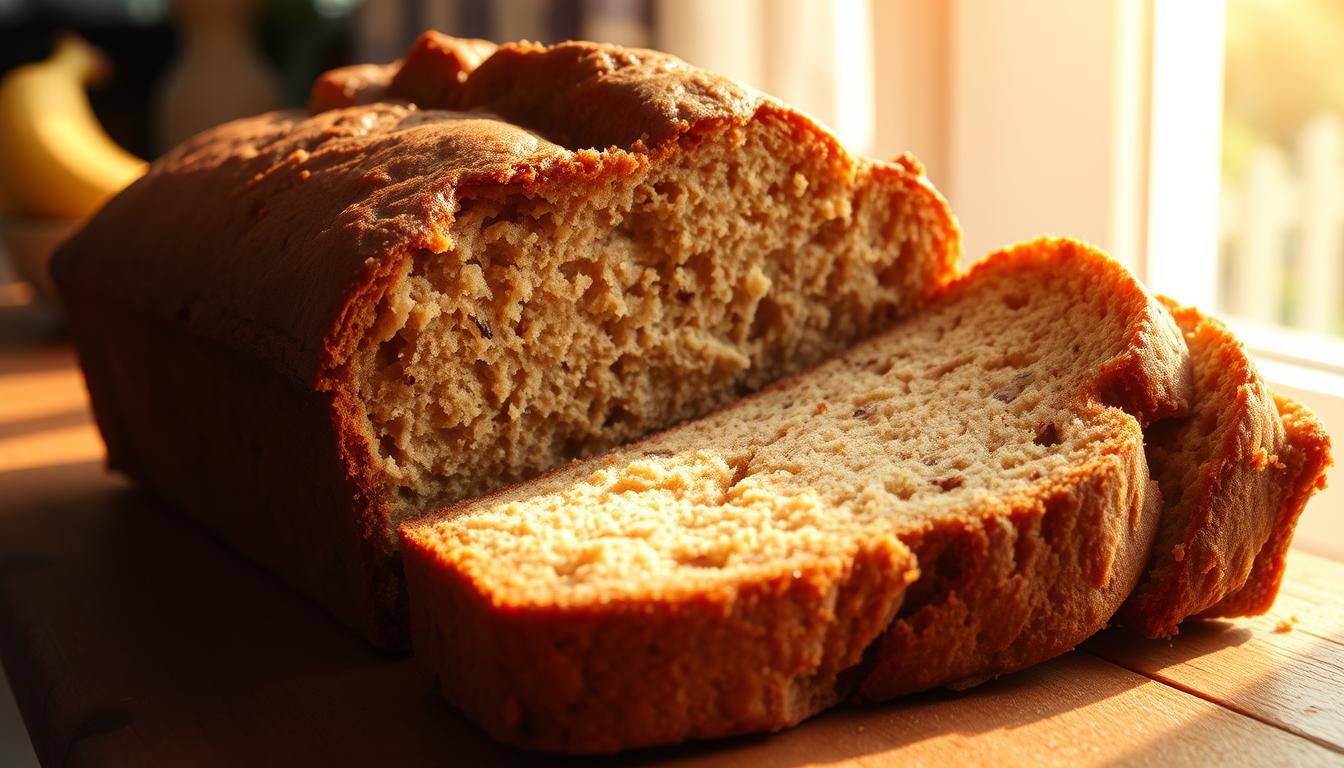Have you ever found yourself with just a couple of overripe bananas and wondered how to make a delicious banana bread without having a bunch of fruit on hand?
You’re not alone. Many home bakers face this dilemma, and the good news is that you can still create a moist and flavorful loaf using just 2 bananas.
This banana bread recipe works exceptionally well because it leverages the right balance of ingredients and techniques to bring out the best flavor and texture.
In this article, we’ll explore five game-changing improvements to elevate your basic bread to a bakery-quality treat that will fill your home with wonderful baking aromas.
Key Takeaways
- Discover how to make delicious banana bread with just 2 bananas.
- Learn the science behind creating moist, flavorful banana bread.
- Preview the five improvements that will elevate your basic banana bread.
- Understand why this recipe works exceptionally well with limited ingredients.
- Get ready to transform overripe bananas into a delicious treat.
Table of Contents
The Perfect Banana Bread With Just 2 Bananas
Aeving the perfect banana bread with just 2 bananas is a game-changer for those who want to enjoy this treat without needing a bunch of overripe bananas. This recipe is designed to maximize banana flavor even with fewer fruits, ensuring that every bite is delicious and satisfying.
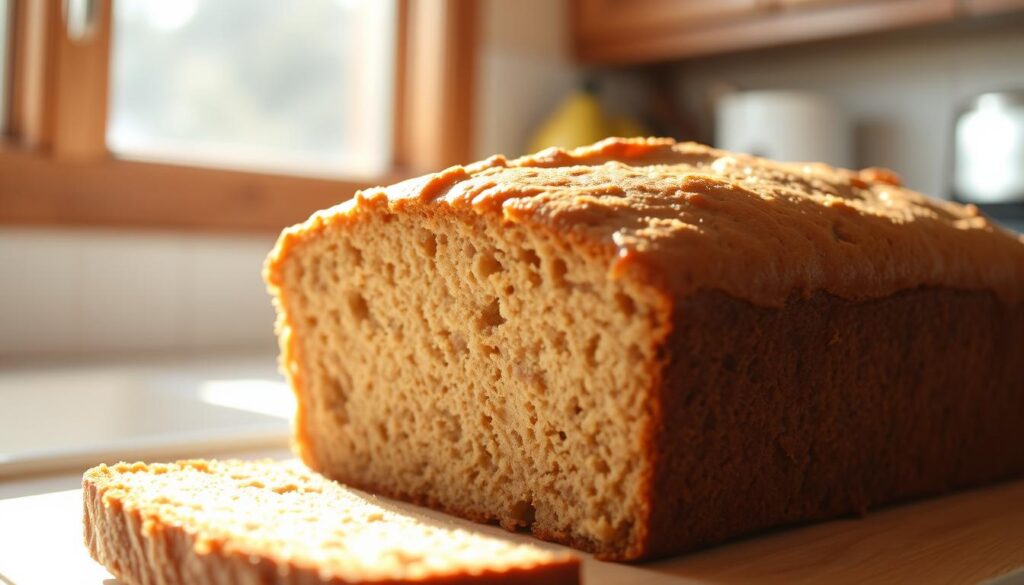
Why This Recipe Works With Fewer Bananas
The secret to this banana bread recipe lies in its ability to balance ingredients perfectly, compensating for the fewer bananas used. By using properly ripened bananas and a precise mix of other ingredients, this recipe maintains the moisture and flavor you’d expect from a traditional banana bread. As one baking expert puts it, “The key to a great banana bread is not just the number of bananas, but how you use them.” The melted butter method also contributes to a superior texture, making this bread a standout.
What Makes This Recipe Special
This recipe is ideal for those who often find themselves with just a couple of overripe bananas. It offers versatility, allowing for customization while maintaining the core banana bread character. Unlike traditional recipes that call for 3-4 bananas, this one caters to those looking to make the most of fewer ingredients. With its light texture and big on banana flavor, it’s a treat you can enjoy without feeling guilty about the sugar and butter content.
Banana Bread Recipe With 2 Bananas
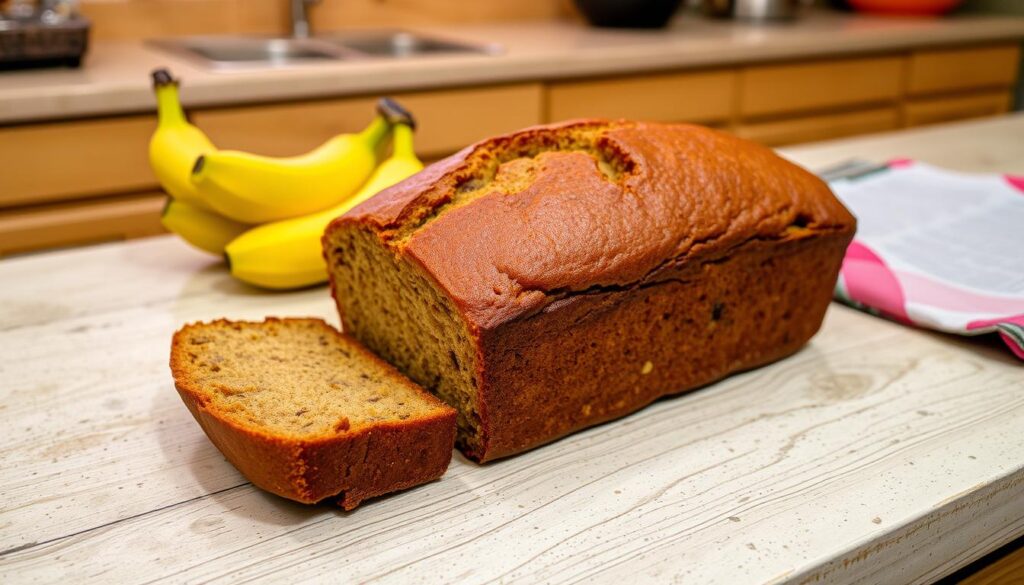
To make a delicious banana bread with just 2 bananas, you’ll need to gather a few essential ingredients and have the right kitchen tools at hand. This recipe is designed to be straightforward and easy to follow, ensuring that you can enjoy a moist and flavorful loaf without needing a large number of bananas.
Essential Ingredients
The ingredients for this banana bread recipe are simple and likely already in your pantry. You’ll need 1 3/4 cups (220 g) of all-purpose flour, spooned and levelled to ensure accuracy. Other essential ingredients include 2 teaspoons (8 g) of baking powder, 1/4 teaspoon of baking soda, and 1/2 teaspoon of salt. For the wet ingredients, you’ll need 1/3 cup (75 g) of butter at room temperature, 2/3 cup (130 g) of white sugar, 2 large eggs also at room temperature, and 1 cup (227 ml) of mashed bananas, which is equivalent to about 2 medium, very ripe bananas.
Using room temperature ingredients is crucial as it ensures that the butter and eggs blend smoothly, contributing to a uniform texture in the final loaf. Properly measuring the flour by spooning and leveling is also important to avoid a dense, dry loaf.
Kitchen Tools You’ll Need
To make this banana bread, you’ll need a few key kitchen tools. An electric or stand mixer is necessary for creaming the butter and sugar together, as well as beating in the eggs. You’ll also need an 8×4-inch glass or metal loaf pan, which is the recommended size for this recipe as it allows for even baking and the right texture. Optionally, you can line the loaf pan with parchment paper for easy removal of the bread after it’s baked.
The choice of an 8×4-inch loaf pan over the more common 9×5-inch size is recommended because it provides the perfect balance between the crust and the interior of the bread, ensuring that your banana bread is neither too dense nor too crumbly.
The Science Behind Perfect Banana Bread
The secret to making perfect banana bread lies in understanding the science behind its ingredients and baking process. To create a delicious and moist loaf, you need to comprehend how different components interact during baking.
The Role of Ripe Bananas
Ripe bananas are crucial for the best banana bread. They contain more sugar, more flavor, and provide better moisture. As bananas ripen, starches convert to sugars, developing those distinctive flavor compounds. If you don’t have overripe bananas, you can make your own by baking them in the oven at 300 degrees F for 15-30 minutes until they’re soft and the skins are dark brown.
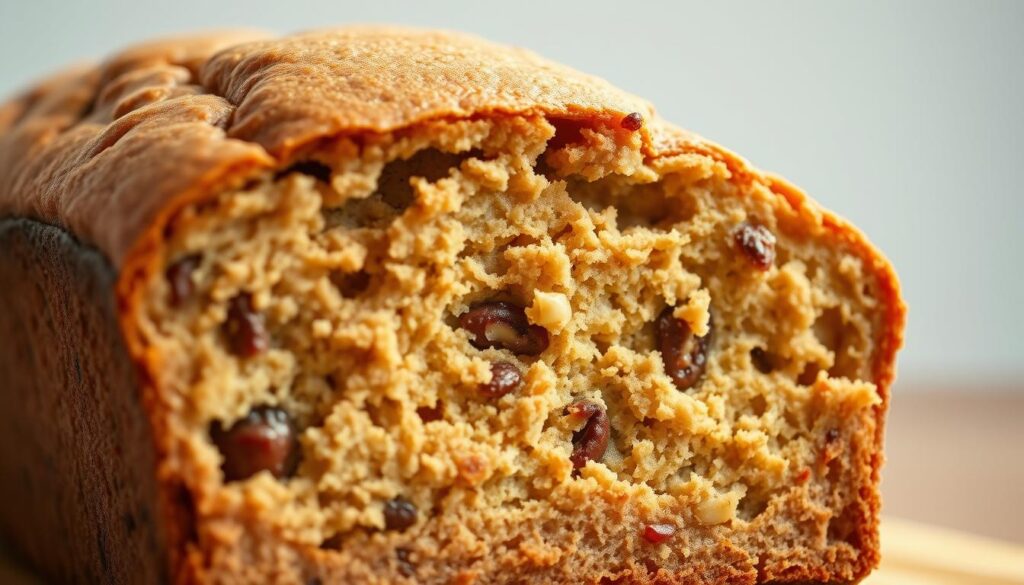
Balancing Moisture and Structure
Achieving the perfect banana bread requires balancing moisture and structure. The flour provides structure, while the butter and bananas add moisture. The proteins in eggs and gluten in flour work together to provide structure, while the fats in butter create tenderness. Understanding this balance is key to a perfect loaf.
| Ingredient | Role in Banana Bread |
|---|---|
| Ripe Bananas | Add moisture, sugar, and flavor |
| Flour | Provides structure |
| Butter | Adds moisture and tenderness |
| Eggs | Contributes to structure |
Step-by-Step Baking Instructions
To achieve the perfect banana bread, follow these detailed step-by-step baking instructions. This guide will walk you through preparing your ingredients, mixing the batter, and baking to perfection.
Preparing Your Ingredients
Start by preheating your oven to 350°F, ensuring it’s not fan-assisted or convection. Prepare an 8.5 x 4.5-inch metal loaf pan by spraying it with cooking spray and lining it with parchment paper for easy removal. In a medium bowl, whisk together flour, baking powder, baking soda, and salt. Set aside.
Mixing The Batter Properly
In a large bowl, use an electric mixer to cream together room temperature butter and sugar until light and fluffy. Add eggs one at a time, beating well between each addition. With the mixer on low, alternately add the flour mixture and mashed bananas, mixing until well combined. Pour the batter into the prepared loaf pan and level the top.
Baking Times and Temperatures
Preheat oven to 350°F and bake for 45-55 minutes. Check for doneness by inserting a tester into the center; it should come out clean. Note that baking times may vary based on the loaf pan material.
| Loaf Pan Material | Oven Temperature | Baking Time |
|---|---|---|
| Metal | 350°F | 45-55 minutes |
| Glass | 325°F | 50-60 minutes |
By following these steps and adjusting for your loaf pan, you’ll achieve a perfectly baked banana bread.
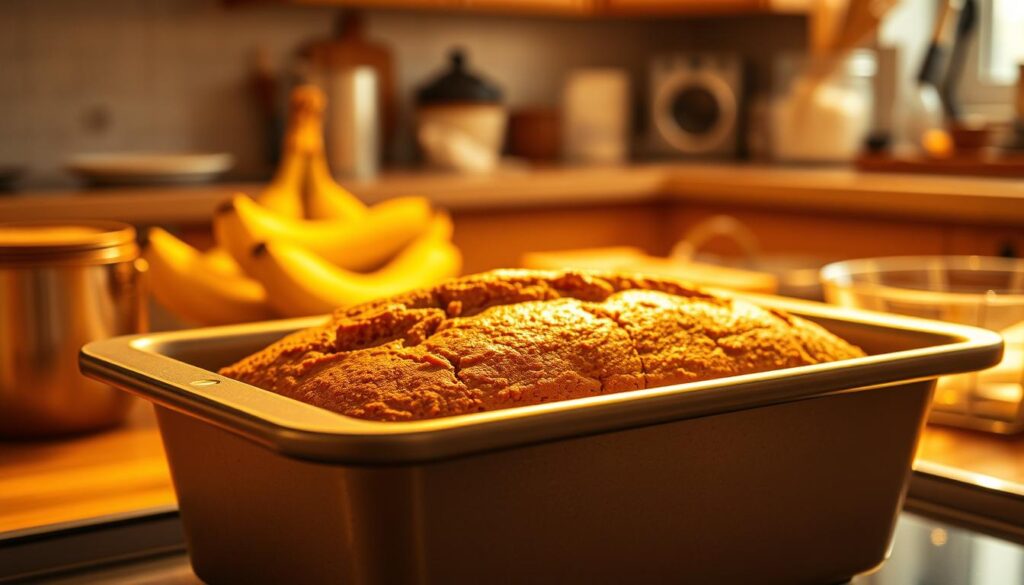
Improvement #1: Elevate With Mix-ins
Elevating your banana bread recipe can be as simple as adding the right mix-ins. By incorporating various ingredients, you can enhance the texture and flavor of your banana bread, making it even more delicious.
Chocolate Chips: The Classic Addition
Adding chocolate chips to your banana bread is a classic move that creates pockets of melty goodness. You can use semi-sweet or dark chocolate chips, depending on your preference. Dark chocolate can offset the sweetness of the bananas, creating a beautiful balance of flavors.
Nuts and Dried Fruits for Texture
In addition to chocolate chips, nuts and dried fruits can add interesting textures to your banana bread. Walnuts, pecans, or almonds can provide a nice crunch, while dried fruits like cranberries or cherries can add sweetness and chewiness.
| Mix-in | Texture | Flavor |
|---|---|---|
| Chocolate Chips | Melty | Sweet/Chocolatey |
| Walnuts | Crunchy | Earthy/Nutty |
| Cranberries | Chewy | Tart/Sweet |
Improvement #2: Flavor Enhancers
To take your banana bread to the next level, consider adding some exciting flavor enhancers. These simple additions can transform your ordinary loaf into a truly special treat.
Cinnamon Sugar Topping
A cinnamon sugar topping can add a delightful crunchy contrast to the soft interior of your bread. To make it, simply stir together sugar and cinnamon in a small bowl. Then, evenly sprinkle a handful of the mixture over the top of your banana bread batter before baking.
Vanilla and Spice Variations
Vanilla extract is another fantastic way to enhance the flavor of your banana bread. Using pure vanilla extract can offer superior results compared to imitation vanilla. You can also experiment with complementary spices like nutmeg or cardamom to add complexity. Additionally, using brown sugar instead of regular sugar can add moisture and a caramel-like flavor that pairs beautifully with bananas.
| Flavor Enhancer | Description |
|---|---|
| Cinnamon Sugar Topping | Adds a crunchy contrast and sweet flavor |
| Vanilla Extract | Enhances banana flavor and adds depth |
| Brown Sugar | Adds moisture and a caramel-like flavor |
Improvement #3: Texture Perfection
Texture perfection in banana bread is within reach when you understand the key factors that influence it. Achieving a moist and tender crumb involves more than just the right ingredients; it requires precise techniques and attention to detail.
The Melted Butter Secret
Using melted butter is a game-changer for banana bread texture. Unlike creamed or softened butter, melted butter creates a moister and more tender crumb. This is because the fat is evenly distributed throughout the batter, ensuring that the loaf remains soft and palatable.
Proper Banana Mashing Techniques
The way you mash your bananas significantly affects the texture of your banana bread. Using a potato masher or a fork to mash bananas in a large bowl allows you to control the consistency. You can choose to leave some chunks for banana pockets or mash until smooth for a uniform texture. This technique ensures that your banana bread has the desired texture and flavor.
Improvement #4: Baking Techniques
Elevate your banana bread game by mastering a few key baking techniques. The right techniques can make a significant difference in the outcome of your banana bread, ensuring it is perfectly baked every time.
Choosing the Right Loaf Pan
The size and type of loaf pan you use can significantly affect your banana bread. An 8×4-inch pan is recommended for this recipe, as it yields a taller loaf. However, if you use an 8 1/2×4 1/2-inch pan, bake for 47 to 57 minutes, and for a 9×5-inch pan, bake for 45 to 55 minutes. Note that a larger pan will result in a flatter loaf. Different materials like glass, metal, and silicone also impact baking time and crust development.
- Understand how pan size affects loaf shape and size.
- Learn about the differences between glass, metal, and silicone pans.
Testing for Doneness
To ensure your banana bread is perfectly baked, it’s crucial to test for doneness. Insert a tester into the center of the loaf; if it comes out clean, the bread is done. Start checking at around 40 minutes by looking for a golden brown top with a crack down the center. If the top is browning too quickly, tent it with foil to prevent over-browning.
- Master the toothpick method for checking doneness.
- Understand the visual cues that indicate your bread is ready.
Improvement #5: Storage and Serving
To keep your banana bread fresh for as long as possible, follow these storage tips. Proper storage is crucial for maintaining the texture and flavor of your freshly baked banana bread.
Keeping Your Banana Bread Fresh
After baking, remove the banana bread from the oven and allow it to cool in the pan on a cooling rack for 10 minutes. Then, remove it from the baking pan, gently take off the parchment paper, and let it cool completely on a baking rack. Once cooled, wrap it well to maintain freshness. Your banana bread will keep at room temperature for up to 4 days. For longer storage, consider refrigerating or freezing it.
Freezing Tips for Later Enjoyment
To freeze your banana bread, wrap it in two layers of aluminum foil and then place it in a freezer bag. Make sure to push out as much air as possible before sealing the bag to prevent freezer burn. Frozen banana bread can be stored for later enjoyment, allowing you to savor it beyond the initial few days.
| Storage Method | Duration | Tips |
|---|---|---|
| Room Temperature | Up to 4 days | Wrap well in plastic wrap or aluminum foil |
| Refrigerator | Up to 5 days | Store in a covered container or wrapped |
| Freezer | Long-term | Wrap in two layers of foil and store in a freezer bag |
Conclusion
By incorporating just a few simple tweaks, you can transform a basic banana bread recipe into a truly exceptional treat. The five improvements outlined in this article will guide you in elevating your bread to new heights.
With these techniques, you can create a delicious, moist, and flavorful banana bread using just two bananas. Feel free to experiment with mix-ins like chocolate chips or nuts to make the recipe your own.
Remember, the art of baking the perfect loaf is all about practice and finding the right balance for your taste. Enjoy the process, and don’t hesitate to share your creations with friends and family.

